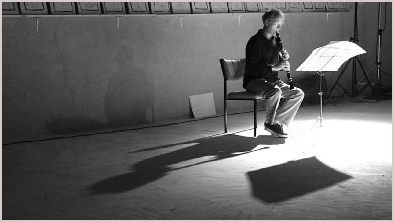Another Timbre TimHarrisonbre
Jürg Frey interviewed by Brian Olewnick
BO: I thought I'd begin by simply asking about your background - I know almost nothing! You and I are about the same age (I think you have me beaten by a year), so I was wondering if you could describe your path as a young man that ultimately brought you to creating in this area of music - what you were listening to when growing up, to be sure, but also other things that turned out to have a strong influence on your basic outlook, aesthetic or otherwise.
JF: Yes, we are almost the same age, which allows me to touch pretty quickly on some events, phenomena and music which perhaps we both experienced in a similar way. My main interest as a 17 year-old teenager was in art. Woodstock 1969 was something I “heard about”, one of my favorite LPs was Deep Purple’s Concerto for Group and Orchestra. Classical music was part of this too, but likewise not very profoundly. I remember one thing from school at the time: I could not make a distinction between Mozart and Vivaldi by ear! But I knew who George Brecht was (Happening & Fluxus was my first art work catalogue in 1970) and free jazz was a model for my own playing on the saxophone. I knew the paintings of Joseph Beuys as well as some of Philip Guston’s paintings. I knew Richard Long’s work from catalogues, as well as the work of Dan Flavin and Carl Andre. I don’t remember any distinction in terms of styles. I was fascinated by Minimal Art and Conceptual Art. I practiced Messiaen’s Quatuor pour la fin du temps on clarinet; it was too difficult at the time, but nevertheless was a defining experience. When I was 19 I wrote a first piece for two pianos, a graphic notation, and I remember experiments in writing music in charts and columns. It was too complicated to play, you couldn’t find your way through the tables - a mixture of styles and genres - and I had to decide if I was to go more into art or into music. My focus went to classical music and I caught up on my deficits and more, I discovered I had a feeling for harmony, form and all the topics of classical music.
Nevertheless, my training followed two different lines: one was the regular training in a music conservatory to become a classical clarinet player, the other is all the rest, which happened at the time more or less outside of the institutions. Let me speak now about my very first composition. Significantly, it’s difficult to say if this is a piece of music or a piece of art. The title is Stück 1975 (for private or public performance) and it consists of 41 sheets of very different quality in terms of size, material, texts, graphics et al. No staves and no pitches, no instrumentation, no duration, no rules for contexts, but references to relationships with styles, fonts, paper qualities. The score exists as two unique pieces: one is in the library at Northwestern University, the other is in my archive. This piece was like a summary of influences and interests from that time, and also a starting point in making steps toward music in the narrow sense.
And this leads me to the other early piece I want to talk about: Lachen und Lächeln (1978) for soprano, violin, clarinet, horn and piano, on a text by the Swiss poet Robert Walser. I didn’t have a clear awareness when I started writing the piece, but had a strong feeling when I had finished it that yes, composition was something for me to go on with. Looking back on this piece today, I recognise characteristics, already present in the piece, which are important for my later work. It happened somehow in this early piece, and I remember the reason that I wrote this kind of piece was not as an exercise in compositional technique or for aesthetic considerations, but because I wanted to write something I liked to listen to. (And of course, I felt that with this music I would be in opposition to normal contemporary music; this was important too!). The piece has a duration of 18 minutes, consists of 8 pieces, No 1-3 are for soprano and small ensemble, followed by No 4-8, which are all piano pieces. The sounds are mostly consonant (unisons, thirds, sixths, octaves). After a short beginning with the whole ensemble, the lengthy remainder of the work is solo piano music; the audience and the other musicians on stage become listeners and the pianist goes on his path alone.
BO: Some reservations about Wandelweiser music (obviously, this is a gross generalization) have to do with what you might call "easy answers", having a worldview, as expressed in the music, that's overly contemplative or dwelling on aspects of beauty as opposed to dealing with the harsh realities of the world. (Personally, I don't see it as an either/or situation, but I'm sure this general criticism surfaces fairly often). So, I guess my question would be: When you're thinking about a piece or while you're composing it, do you consider extra-musical aspects (for example, things occurring in the political world and how the music relates to it or is shaped by it) or do you think of the music as self-contained, jewel-like if you will, wanting it to be appreciated in isolation? Or both - Morandi's art, which we'll get to a bit later, seems to cover both worlds, the latter (social) implicitly.
JF: Here many different things come together, and the danger is that they are simplified too much. I will try to clarify: “do you consider extra-musical aspects (for example, things occurring in the political world and how the music relates to it or is shaped by it)…” If this means that a composer should react in his work to an earthquake in Nepal or boat people in the Mediterranean, then no. Mostly this would be a clumsy way to attract attention. Neither art nor political processes should be limited in this way.
With respect to general political music, I can't remember any so-called political
music making an impact on my life. For instance, Christian Wolff's music: I agree
with him in many aspects of his political stance, but his music did not sharpen my
mind in this respect. But his work as a composer is inspiring to me, how he works
with ensembles, notation, scores, relationships, - and if this can be seen as a ‘political’
aspect in his music, I'm fine to call it political.
In my work, I consider each note as an individual, I respect each note as a sound personality. This may also be one of the reasons why I continue to compose by hand: I can give my attention to every note. I take responsibility for the note, and I also want that every note itself feels good and right in its place and in the context. And with this work ethic follows a similar attitude towards the musicians: I respect each musician as a personality, I count on their skills, their musicianship, and I hope to write music for them that is rewarding, and for which it’s worth taking responsibility. In this way I am seeking personal and social transformations.
I also don't think that a music that is “dealing with the harsh realities of the
world” has more to do with life than one that is “contemplative or dwelling on aspects
of beauty.” And "easy answers" are possible with any kind of material: a major chord
or 12-tone cluster or a field recording or a noisy bang. Or just a simple pitch.
But
there is a lot of potential in the term "easiness", and of course it’s an important
issue: easiness is wonderful, why make things more complicated than necessary? But
on the other hand, things are complex, and silly simplification is not easiness but
stupidity. But I do not resist an elegant solution.
“Do you think of the music as self-contained, jewel-like if you will, wanting it
to be appreciated in isolation?” No. Again I feel it as a limitation to think of
my music in a certain context. But on the other hand, my music is something to listen
to. It works well when the listener focuses. My music is for the ears and for the
eardrum. The eardrum is a gateway to the body, the mind and the soul, and I respect
the eardrum as a very sensitive thing. (And for other characteristics than just the
sound itself - form, duration and other things more connected to mind and feelings
- my music can be edged and rough).
“Is there an overarching idea or "goal" with
a given piece, somewhere you are looking to reach, some idea you're looking to express,
or do you let the notes determine what is reached or constructed?” I understand art
in general, and my music too, as an intensification of life. It makes existence more
intense, makes the individual being richer and the understanding of what life could
be, more colourful. In my music, it can be done by silence and stillness, by precisely
selected pitches, by sensations of shape and transitions, by hesitation or movement....
BO: Maybe we can begin to talk about the recording, Grizzana, at the same time being able to go back to some of these issues. First, having used his hometown as the title of the collection, would you like to talk about Morandi and his meaning for you?
Second, I'm curious if the pieces here were intended as a group, related in a general or specific way. One of the first things that came to mind after having recently listened (frequently) to your album on the Musiques Suisses label was how relatively astringent these works are. Perhaps only because of knowledge about the Morandi connection, I find myself "tracing" Morandi-like still lifes with those sandy string lines, for instance, sketching the shapes in, as it were, with the sounds, a very enjoyable preoccupation! I think you describe this music as "drier" or "less lush"; astrigency, technically, has to do with something that makes your lips pucker, like lemon! Maybe "chalky" (which might also lead to Morandi....)
JF: The work of Morandi has been part of my own work for many years, and for a long time I was looking for a possibility to express my respect to the painter. When Simon Reynell asked me for the details of a programme for this CD, I saw the opportunity to write a new piece to concretise my admiration for Morandi.
Morandi’s painting is figurative painting, but at the same time, he works with aspects of abstract painting. So you can see him also as an abstract painter who works with objects. To make a link to music (and sorry, I have to simplify it now, but in the daily process of my work, this reflection develops the whole richness of complexity), I can understand a melody as like a figurative part of a painting. Similarly to how you can remember melody as a “thing“, as a motif in music, you can see on the canvas a bottle, a house (and some painters speak about “working on the motif”). So on the other hand, in music the sound (just the sound) can be seen as an equivalent to abstract colour.
With this image in the background, you can listen to many of my pieces from the past. Sometimes it goes more to the abstract side, sometimes more to the figurative, but in general it takes a clear position between the two. It happened unconsciously in the earlier pieces, and later I discovered this image of abstract / figurative to find words to speak about the music. And the piece Grizzana maybe uses this more consciously in the focus of the composition.
But let me finish these reflections on Morandi with a quote. Sean Scully wrote in his essay about Giorgio Morandi: “His brushstroke is in complete philosophical agreement with the subject, the scale and the colour of his painting. It is expressive, though it is modest, and not so expressionistic as to disturb the sense of meditative silence that inhabits all his works.”
The pieces on the Grizzana album are not connected as one complete group (except they were all composed in the last few years and therefore they often revolve around similar content and compositional questions), but some of them are connected and composed in parts and subgroups.
Some of the pieces have more than just a musical background, and two personalities are important in this context: one is Morandi, the other is the Swiss poet Gustave Roud (for the pieces with French titles). Both artists have similar biographies. Morandi lived all his life in Bologna (except when he visited his summer house in Grizzana), Gustave Roud’s life was centred on the small landscape around the village of Carrouge, north of Lake Geneva. And in their work, both concentrate on a few topics to discover essential dimensions of human life. Morandi’s work focuses on still lifes with bottles, and landscapes, which are also important for me. Gustave Roud recognised the existential dimensions in the daily life of his friends, in the finest nuances of the weather and changes of the atmosphere of the landscape, and he made these perceptions the basis of his literary work.
The other works on the CD are composed for different occasions: A Memory of Perfection was a suggestion of violinist Erik Carlson (the title is a quote of Agnes Martin and the piece refers to my 2nd string quartet). Area of Three and Ferne Farben were first performed during Wandelweiser weeks in Neufelden (Austria), and Fragile Balance was written for Nomi Epstein and the ensemble a.pe.ri.od.ic.
I agree with you about the characterisation of the music as “drier“. Here the music is less lush compared to the Musiques Suisses recordings. What you call "astringency" is clearly audible in the aspect of canons and counterpoint in several pieces. Sometimes, as in Lieues d'ombres, it refers to all the rigour of canon writing, but mostly it opens onto a more vague idea of canon and counterpoint. This is a paradox, because the canon is one of the most severe forms of composition. But I deal with this paradox, because I’m seeking a certain kind of expression. It happens during the performance, when the musicians are balancing between the given score and the notion/idea of the playing of the other musicians. The atmosphere, the base colour and the shape are similar in every performance, but the details are different. Sensitive reactions to different tempi and unpredictable cues from other musicians create this vague path between risk and surprise and keep it in a "fragile balance".
“Maybe "chalky" (kreidig) (which might also lead to Morandi....)” I like this remark. I never thought about "chalky" when I wrote Grizzana, though of course I had Morandi's work as a whole present in my mind. It is a good example of how a strong flow in the background can have an impact on a work. I think the colours in the piece are pretty near to Morandi's chalky blue, purples, brown and yellow shades.
BO: You mentioned canons. Why have canons become prominent in much of your recent work?
And would you elaborate a bit more on Gustave Roud and his meaning for you? My French isn't nearly good enough to do justice to the originals but in the few English translations I've found, I can certainly see some affinity with regard to his, as one writer put it, "romantic sublimity and classical restraint".
JF: I wrote my first canons in 2002 and 2003. Before, I had resisted the idea of
using canons and had even rejected any connection of my music with canons. My impression
about my music at that time was: I have to touch every sound individually and to
put it in its place in the timeflow. And in this context the canon was just an automatic
mechanism, outside my interests. The first canon I wrote is Glafsered. The title
refers to the name of a small village in Sweden, the residence of Björn Nilsson,
and this curator's strong interests in canons and counterpoint gave me the impetus.
My first canons are strong scholastic works with respect to the technique of composition.
But the material and the sounds are flat, bland and non-specific. You cannot hear
a canon structure (though you can see it in the score). Or, as in Unhörbare Zeit(1),
most of the music is silence with very few sounds; so to speak, silences in a canon.
Later I opened up this scholastic approach to a more flexible one. And I told myself,
a canon is simple: it's the same or a similar thing, but it happens later, the same
activity, and later again, the same and later again. And when I walked through the
streets, I saw canon structures everywhere in daily life - it's not just a musical
phenomenon. And I started to research the possibilities between openness and strict
writing.
This gave me the opportunity to write pieces like canones incerti, Vague
Canons, Circular Music, and many others whose titles are not directly related to
the canon. Most of them are with sounds and music, but a piece like this is also
part of my interest in canons:
11:30 Eat a fruit
12:17 Say a word clearly and quietly
12:43 Read silently one page in a book unknown to you
14:21 Play or hum a scale of six tones
14:24 Think of someone you'd like to kiss
14:35 Take a picture with your camera
15:20 A long flat noise, very quiet
This is the first voice of a time and activity structure during a day; a second and
a third voice start each 10 minutes later.
I have recently written some very strict
canons, but I am more interested in insecure canons and counterpoint structures.
I see arising a precise musical expression of tenderness, clarity, risk and a groping
when musicians act in an open canon structure.
And another aspect of the canon I’ve
begun to understand: once I have found the right notes, sounds and pauses, I can
let the music go on by itself, I don't need to touch them again, I don't have to
think about new energies, other directions, I can just listen and it goes on by itself,
lovely.
As to Gustave Roud: when I look at my artistic interests as a wide panorama, then
at first the Canons and Gustave Roud are far away from each other. A canon is a technique,
a structure and "some kind of a music" is already in the background, and I try to
make this situation useful for my work. Gustave Roud seems to be the opposite: it's
pure sensation, emotion, and my desire is to find a structure, the sounds and a score
for all these feelings.
Gustave Roud's oeuvre is deeply connected with his living
in Carrouge and his walks around a few villages in the neighbourhood of the Haut-Jorat. I
consider his work as a kind of "field recording" at a clearly defined place, during
a long period of more than 50 years, not with a microphone, but with his sketchbook,
and not just for sounds, but also for colours, shades, subtle changes of the fields,
trees, flowers, scenes, and details of working or resting farmers, the seasons, and
his own thoughts and feelings. And similarly to the way in which a microphone takes
in every sound, Gustave Roud reacted to the finest and most delicate impressions
in the environment and in his feelings. When he made his walks (and I imagine slow
walks, with long stops and time just looking at the landscape), he always had his
sketchbook with him to write down his observations and thoughts. These sketchbooks
are the basis of his work.
Roud’s oeuvre has accompanied me for nearly ten years. This
coming-together is maybe more in the background, because on the surface his work
also speaks about experiences of just living in the rural countryside. “Romantic
sublimity and classical restraint" is for sure part of his work, but inside, in the
nucleus, I see a relationship to what I’m doing, outside of a simple assignment to
a genre. His texts remain a strong inspiration for me and give me a strong insight
into the depth of how to make art. Similar to my work, where I try to translate feelings,
notions and intuitions into signs (these are the black and white dots and lines on
the five line stave) to create at the end a score, so Roud tries to translate his
first unnamable observations into words and sentences to achieve at the end a poetic
work.
And another thing, maybe more in parenthesis: to read the texts by Gustave
Roud is a pleasure for me, precisely because my French is not fluent. It slows down
the reading and makes it similar to his walking in the landscape, standing idle,
listening, thoughts, walking again....
BO: I didn't know Roud's work at all but, searching around, I see at least one reason why: very little has been translated into English as near as I can determine (and my French is, I'm sure, far worse than yours). I did locate one passage here. I've no idea about the quality of translation, of course, but between this and your description, I can get at least a glimmer of the connection with your music and, sitting here now listening, find myself hearing the work in a slightly different and very rewarding light. It's always fascinating to me how extra-musical knowledge can enhance one's experience of music, either in the moment or even retrospectively. I've been listening through your set with that "slowly walking around" frame of mind, sometimes imagining catching a glimpse of a Morandi through a window--very rewarding, very special. "Lieues d’ombres" works especially beautifully, for me, this way, both the observational and canonic aspects.
JF: Thanks for this remark about the connection between me and Roud and your experience
when you listened again to the pieces with the background of the Roud text. Actually,
this text, which is part of Air de la solitude, is one of the initial inspirations
for my compositions with Roud, and Petit fragment de paysage is a quote from this
text, Pouvoir d'une prairie:
"A power still more mysterious in the case of an isolated
fragment embedded in the larger landscape...” (Pouvoir plus mistérieux encore s'il
s'agit d'un petit fragment de paysage qui s'isole à l'interieur de grand...")
Email interview conducted by Brian Olewnick, spring 2015
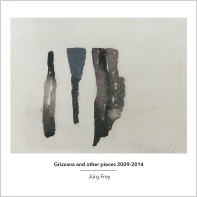
at86x2 Jürg Frey - Grizzana and other pieces 2009-2014
Ensemble Grizzana - Jürg Frey (clarinet), Mira Benjamin (violin), Richard Craig (flute), Emma Richards (viola),
Philip Thomas (piano), Seth Woods (cello) and Ryoko Akama (electronics)
Disc One
1. Petit fragment de paysage (2009) 5:08
version for clarinet & cello
2. Fragile Balance (2014) 13:42 youtube extract
3. Ombres exactes sans dûreté (2009) 9:41
4. A Memory of Perfection (2010) 9:30
5. Extended Circular Music No.8 (2014) 16:46
6-12. Grizzana (2014) 18:44 youtube extract
13. Petit fragment de paysage (2009) 5:02
version for organ and piano
Disc Two
1. Petit fragment de paysage (2009) 5:13 youtube extract
version for violin and viola
2. Lieues d’ombres (2009) 14:53
3. Tendre enchaînement des valeurs (2009) 8:40
4. Ferne Farben (2013) 12:16
5. Area of Three (2013) 30:52
6. Petit fragment de paysage (2009) 4:58
version for flute and viola
Photo: Joachim Eckl
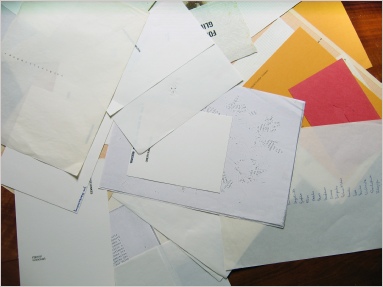
‘Stück 1975’
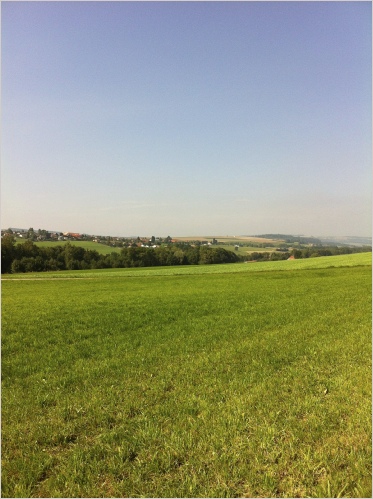
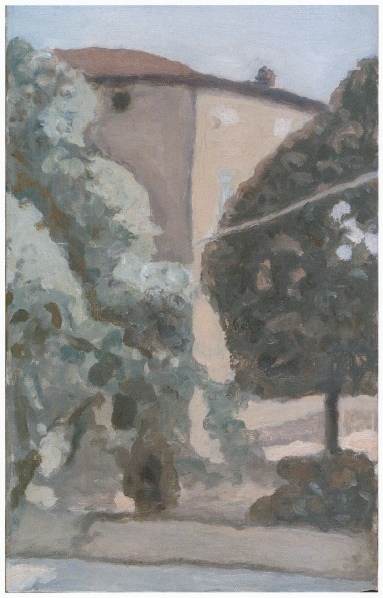
‘Paesaggio’ by Girogio Morandi
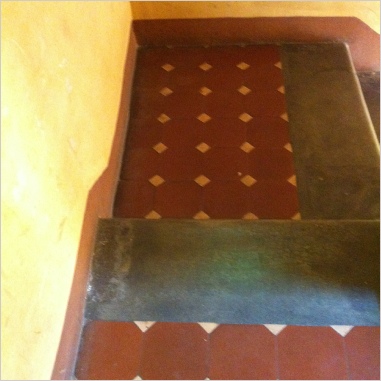
Carrouge, Switzerland
Stairwell at Casa Morandi
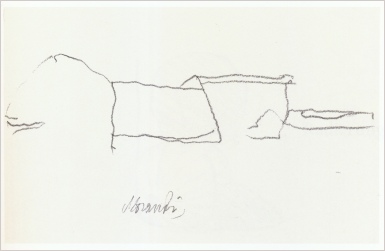
‘Paesaggio’ by Giorgio Morandi
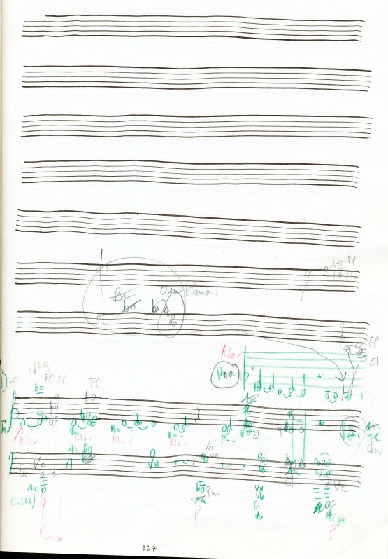
‘Grizzana’ Sketchbook
Reviews
“Sheffield label Another Timbre is enjoying a bumper 2015, with John Tilbury and Philip Thomas’s marvellous double set of Morton Feldman’s piano works followed by a succession of standout releases from Frank Denyer, Common Objects, Magnus Granberg and James Saunders. The momentum is maintained with this substantial overview of the recent work of Jürg Frey, a Swiss composer who has a long and prolific association with the Wandelweiser imprint and collective.
Any typecast notions of spartan silence and schematic conceptualism are immediately dashed by ‘Grizzana and Other Pieces’, whose beguiling series of compositions are predicated to a surprising degree on conventional tonality, follow a discernible linear compositional logic, and happily deploy simple intervals and unadorned harmonic constructs to explore transparent contrasts in pitch and textural relationships. All ten may be Wandelweiser-like in their self-imposed limitations – most obviously a slowness of pacing and clear structural restraints – yet each is in different ways intensely sensuous, as well as preternaturally alert to the acoustic potential of spatial and dimensional divergences.
Performed sensitively by Ensemble Grizzana, the album is an epic study of fragile balances, to borrow one of the set’s titles. Even its most complex and multi-layered works – ‘Extended Circular Music No.8’ for septet and the seven part title track for sextet, both from 2014 – sound perilously collapsible and feather-light, assembling string and wind-drones and piano detailing into melodic convergences and shimmeringly dense drone harmonics.
‘A Memory of Perfection’ for solo violin from 2010 focuses on more stridulent textures, and other pieces examine degrees of fragmentation. ‘Lieues d’ombres’ for solo piano is a pointillistic arrangement of limpid chords, whose shifts in rhythmic patterns and mutating melodic linkages subtly though persistently threaten disintegration. The 31 minute ‘Area of Three’ for clarinet, piano and cello, falls apart before reconfiguring, its middle passage a flow of abstracted gestures separated by bouts of silence.
Harmony has the final say, however. Both discs are bookended by readings of ‘Petit fragment de paysage’ for duo, each by a different instrumental configuration. Simple in form, yet meticulously focused and detailed, its sustained chords and drones overlap in simple yet powerful, almost profound melodic confluences and counterpoints, in the process speaking eloquently to the virtues of restraint and engagement with tradition.” Nick Cain, The Wire
“There’s a piece by Jürg Frey on the 2012 Another Timbre collection “Wandelweiser und so weiter” titled ‘Un champ de tendresse parsemé d’adieux’ (‘A tender field strewn with goodbyes’), which consists of what sounds like small stones being tossed across a hard floor: there’s silence, a few quiet bounces increasing in frequency as they die away, then silence again. After many stones have been thrown, soft whistled descending glissandi, like distant doodlebugs, begin to fall, even as stones continue to be tossed beneath them. The piece is remarkable both for the clarity of its idea and its emotional impact.
The image of the scattered stones accumulated at the end of ‘Un champ de tendresse’ presents itself frequently as I listen to Frey’s new double CD “Grizzana and other pieces 2009-2014”, again on the Another Timbre label. Does the way in which impressions accumulate, from note to note and from listen to listen, explain how it usually takes me a while to really hear Frey’s music? The first couple of playbacks generally draw a blank; even once I feel I’ve made a connection with a particular piece, the next listen may baffle me again. Each listening ends with a different pile of stones. Even those familiar with Frey’s compositions for chamber ensemble may be surprised by the vague, hazy hues of ‘Ferne Farben’ and the deep-throated growl of ‘Area of Three’, both of which stand out against the luminosity and clarity of most of the album.
The pieces on “Grizzana” aren’t performed using stones, but rather clarinet, violin, flute, viola, piano, cello, organ, and occasional electronics. The composer, in an interview with Brian Olewnick on the label’s website, mentions that he thinks of each sound as being like a person, but I hear it (him/her?) as an event, discrete and specific in space and time. Many of these events are clearly related to one another in a structure: I hear repetitions and returns, translations and transitions. Certain chords and cadences come back again and again. What I don’t hear, however, is the beginning, middle, end of a narrative (or the statement, development, and recapitulation of a theme). Instead, there is a ‘now’ and a ‘then’ (…and then… and then…). This ‘slowness’ (I associate it with my brain struggling to synthesise the events into sequential patterns due to the duration of each and their distance in time from one another) generates uncertainty and perhaps instability, troubling any interpretation of the music as mere surface beauty.
The lightness of the movement from event to event, where the next event is frequently a silence, makes the music seem open and permeable, and any ending almost arbitrary. I sometimes imagine a dance performed in the dark, with only the squeaks and slaps and gasps of movement being perceptible. (Is there any form of dance performance closer to the Idea of dance? And yet: whose Idea?) I do wonder if brains more attuned to the complexity and extended development of late Romantic scores would be less perplexed, less bewildered, and therefore perhaps less enthralled by Frey’s music than I, but for me, at this time, it’s pitched just right.” Nathan Thomas at Fluid Radio
“Years ago I made the passing remark that if Morton Feldman’s music can be compared to Rothko (as it often is) then Howard Skempton’s can be compared to Morandi. The use of melody and conventional harmonic patterns creates a beguiling sensation of familiarity. That initial impression is deceptive, precisely in that it doesn’t try to deceive: representation in one and functional harmony in the other are left exposed, revealed as artifice – yet they still convey their effect (or affect).
Late last year I heard Jürg Frey and a small ensemble play a concert of his recent music. At the time I wrote that:
Some of Frey’s music that I’ve heard seems, to some extent, a provocation in its refusal to yield to an implied, wider palette of sounds. (This is particularly after hearing R. Andrew Lee play Frey’s piano music.) On this occasion, there were also some surprisingly rich sounds, with an almost playful (on Frey’s terms) exploration of harmonies and instrument combinations.
The album of Frey’s music that was recorded around the same time as that concert has now been released by Another Timbre as a double CD, titled Grizzana and other pieces 2009-2014. After hearing the concert I said that, “It will be interesting to hear the music apart from the theatre of performance.” It sounds even more tender and yielding than I expected. Is Frey mellowing with age, or am I just getting acclimatised?
I listened again to Lee’s excellent first CD of Frey’s piano music. There’s a striking contrast between those earlier works and the newer pieces on Grizzana. There’s that notorious passage in Klavierstück II where the same perfect fourth is repeated 468 times. When repetitions appear in the newer music they provide a sense of continuity, not of stasis or impasse. The music alters the listener’s perception of the world through its complex sensory effect more than through any aesthetic dialectic. (Morton Feldman distinguished his own music from John Cage’s by highlighting the didactic tendency in Cage: “Most music is metaphor… I am not metaphor. Parable, maybe. Cage is sermon.”)
I’m reading that interview with Frey about the new CD and – what do you know? – he’s talking about Morandi:
“Morandi’s painting is figurative painting, but at the same time, he works with aspects of abstract painting. So you can see him also as an abstract painter who works with objects. To make a link to music (and sorry, I have to simplify it now, but in the daily process of my work, this reflection develops the whole richness of complexity), I can understand a melody as like a figurative part of a painting. Similarly to how you can remember melody as a “thing“, as a motif in music, you can see on the canvas a bottle, a house (and some painters speak about “working on the motif”). So on the other hand, in music the sound (just the sound) can be seen as an equivalent to abstract colour.”
I could have just read further and quoted that instead of typing all the above.
Frey’s recent music is imbued with a quiet sophistication – the sort that doesn’t need to display its radical nature, its erudition. Where it was once necessary to make statements (like in the six-hour, almost inaudible electroacoustic collage Weites Land, Tiefe Zeit) it is now possible for these values to be affirmed as a given. The piece Ferne Farben, for example, uses field recordings in a way that may not even be noticed on casual listening, giving additional life, space and colour to the otherwise very slow and quiet playing of the acoustic instruments. Or perhaps, listening to it yet again, it’s the other way around.
As might be expected, the performances by Frey himself and his “personal army” are beautifully clear and evocative. Aspects of this album recall last year’s double CD of Laurence Crane’s music, released on the same label: a sustained mood of ambiguous detail, unbroken surfaces over hidden depths. Frey’s music here, however, creates a strange double image in which each sound feels tentative yet inarguable, like a delicate organism. In the trio Area of Three, sustained sounds are inflected with the quietest, briefest notes that pass almost like accidents, silences pass like clouds. Appropriately, another of the pieces is titled Fragile Balance.” Ben Harper on Boring Like a Drill
“Back in 2007, at the outset of his label, Simon Reynell speculated that about one-third of Another Timbre releases would be contemporary classical with the other two-thirds being improvised, split between European Free Improv and electro-acoustic improv. With the benefit of 20-20 hindsight, we can see that the label has evolved and the reality has become very different, particularly in recent years. Although the boundaries between the two are never cut and dried, Another Timbre discs featuring compositions have increasingly outweighed those featuring freely improvised music so that they are now in the majority.
A crucial turning point in that evolution (hindsight, again) was the release of that six-disc Wandelweiser box, on which Jürg Frey featured prominently as composer and performer. The clarinetist was also featured as a player on the excellent double CD Cantor Quartets (Another Timbre, 201) of compositions by Antoine Beuger, so it seems proper that Frey's own compositions now get their own two-disc showcase. The album is structured around four separate versions (one opening and closing each disc) of "Petit fragments de paysage," each one with a different pair of instruments—clarinet/cello, organ/piano, violin/viola, flute/viola. All four versions have a mellow, tranquil atmosphere and duration close to five minutes; despite the differences of tone and timbre, they achieve similar moods with their two instruments fitting together perfectly, a credit to Frey's writing. Just as important to the album is the title composition "Grizzana," a suite of seven pieces ranging in length from just under two minutes to nearly four. On them, the all-acoustic sextet of clarinet, flute, violin, viola, cello and piano creates a slowly-evolving soundscape in which every single sound is savoured and afforded equal status. Beautifully simple and simply beautiful.
Everything else on the album attains the same high standard as those pieces. "Extended Circular Music No.8" (which blends Ryoko Akama's electronics with the "Grizzana" sextet) is a continuation of the exquisite series of seven pieces, composed between 2011 and 2014, that were featured on Jürg Frey (Musiques Suisses, 2014), performed by Mondrian Ensemble and Konus Quartett. The album's longest track, at nearly thirty-one minutes, is "Area of Three," a trio of clarinet, cello and piano; it never settles for "just" being a trio but uses that as the basis for a varied and far-reaching three-way interaction between them which builds an intense atmosphere. Altogether, an essential album.”
John Eyles at All About Jazz
